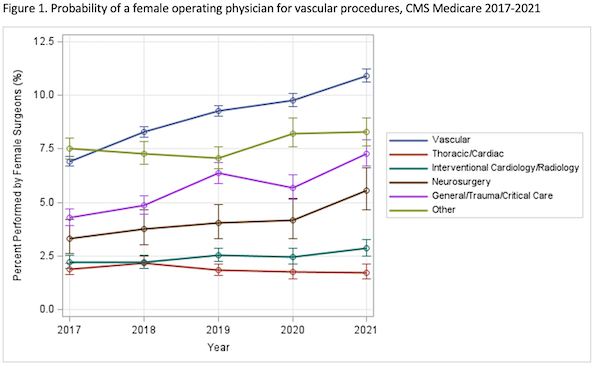OBJECTIVES: Historically, the medical profession has been a male dominated field. While the number of women entering surgical specialties is rising, this increase is not proportionate to the composition of medical school graduates, which are now 50% female. This study aimed to investigate the specialty and gender of practitioners performing common vascular procedures.
METHODS: Medical claims data was obtained from the Center for Medicare and Medicaid Services (CMS). Claims were linked to provider characteristics in the National Plan and Provider Enumeration System (NPPES) using national physician identifier (NPI). The study included final billing records from inpatient claims 2017-2021. Procedures of interest were identified by the primary ICD 10 procedure codes. Provider taxonomy, gender, tenure, and region were derived from NPPES.
RESULTS: Among all specialties, board certified vascular surgeons performed the highest percentage of open infrarenal aortic interventions (70.5%), endovascular aorta repairs (EVAR, 67.4%), carotid endarterectomies (CEA, 60.7%), endovascular carotid interventions (33.4%), open arteriovenous fistulas (AVF, 61.3%), endovascular AVF (61.1%), open infrainguinal interventions (73.6%), and endovascular infrainguinal interventions (47.1%). For the two categories where vascular surgeons performed less than half of the procedures, the next most common specialties were interventional cardiology/radiology (20.8%) and neurosurgery (13.6%) for endovascular carotid interventions and interventional cardiology/radiology (25.1%) for endovascular infrainguinal interventions. Over the five-year period, the percentage of procedures performed by vascular surgeons increased for all categories except endovascular AVF. Analyzing by gender, the majority of all procedures were performed by male physicians, which ranged from 88.6% (endovascular AVF) to 94.7% (endovascular carotid intervention). Over the five-year interval, however, all specialties had a significant increase in the percentage of vascular procedures performed by females (P<0.05) except thoracic/cardiac surgery. Among all specialties, vascular surgery had the greatest absolute increase in female performed interventions (Figure 1, P<0.05).
CONCLUSIONS: While the majority of vascular interventions are still performed by male practitioners, the proportion of procedures conducted by females is increasing. Among all specialties, vascular surgery has both the highest proportion and greatest absolute increase of vascular procedures performed by women. Future recruitment efforts should focus on continuing to reduce this disparity. 